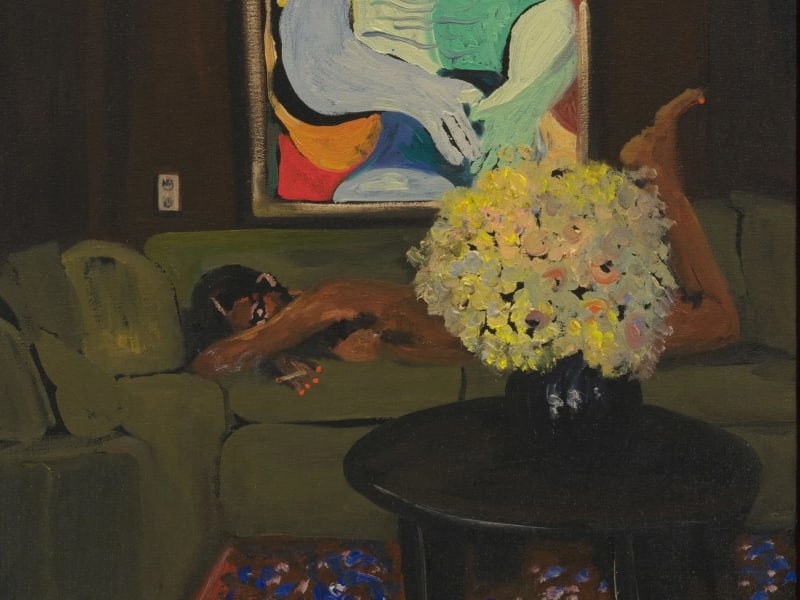BY HOLLY E.J. BLACK
Danielle Mckinney has always built domestic spaces. As a child the artist would take stacks of old magazines supplied by her mother, and carefully cut out hundreds of figures, objects and pieces of furniture before spending hours painstakingly pasting them into shoe boxes. The resulting collages imagined a protective female domain bursting with stories of her own making, and carefully shielded by four flimsy cardboard walls.
This sensibility, which McKinney refers to as a ‘subconscious doll’s house’, forms the crux of her paintings. Though often diminutive in scale, each work acts as portal to lushly decorated (and decidedly low-lit) rooms where women languish in delectable solitude. Figures stretch out, either nude or clad in lounging robes, alone with their thoughts and surrounded by the trappings of a well-furnished home. Each glossy canvas shines like a jewel, not only through a deft balance of dark and umber hues occasionally suffused with glimmering metallic pigment, but her masterful yet sparse use of bright shades. These carefully considered brushstrokes build relationships between painted lips and velvet throw cushions, or else a vase of flowers and a kindred floral bedspread. Each woman is at one with her space.
For Mckinney, who originally trained as a photographer, drawing a picture from out of the darkness comes naturally. She begins with a black canvas, building a distinct, intimate mood that feels practically clandestine. She refers to the ‘punctum’, a visual device in which an unexpected, poignant detail acts as an emotive anchor. While a camera might capture this sense in a single moment, McKinney builds layers in which a lamp, book or smouldering cigarette might trigger a viewer’s response. Her loose brushwork only ever alludes to detail, as opposed to fully fixing it, thus allowing the eye to fill in the blanks. It’s a technique that encourages us to keep gazing not only at the woman in question, but everything that surrounds her.
In the artist’s newest pieces, currently on show at Galerie Max Hetzler in London, the most unexpected adornments come in the form of incongruous works of art, which hang on the walls of her imagined homes. Paintings by Matisse and Picasso appear illuminated yet secondary within these rooms, strangely comfortable in their domesticity. For Mckinney, including these references is less about upending grand historical canons and more about paying homage to the emotive ideals of artistic modernity, where conveying a feeling is paramount. Nevertheless, one cannot help but draw a connection between the self-assured Black women that command their own space and the abstractions produced by men that hang behind them.
Elsewhere, more subtle allusions to art history cement a centuries-long obsession with depicting domesticity. In Crux (2025) the view of a dining room is framed by a doorway, which must surely be a nod to Johannes Vermeer. The Dutch master used this device again and again in his scenes, to make it seem as if one has just walked in on a private moment. In McKinney’s interpretation, a blue vase filled with daffodils continues the Netherlandish reference, while a woman looks on with her arms raised in a satisfying stretch, and practically engulfed by the shadows that surround her.
There is only one work on show that depicts a figure taking in her own image. Magic Mirror (2025), much like other pieces, is an exercise in gloriously subtle tone, yet in this scene there is no clear delineation of recognisable space. Instead, it is as if she is suspended within a collaged circular fragment, enraptured by her barely perceptible reflection. In this case there are no familiar objects to grant tangible access to the world she inhabits, yet she remains at ease. In this moment, she is in room entirely of her own.


